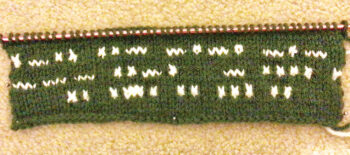
Knitting Morse Code
Diana Oleson
As far back as 1914, women have knitted for soldiers during war time, so it wasn’t uncommon for a woman to be sitting at her window knitting and watching the passing trains. As a train passed, she would make a bumpy stitch, for one type of train, then, when another passed, she would make an intentional hole for another type of train. Later, she would risk her life by handing the finished scarf to a soldier—a fellow spy in the Belgian resistance, working to defeat the occupying German force. It was easy to hide a coded message in a knitted piece since there are only two stitches: a knit stitch looks like a “V” and is smooth and a purl stitch, which looks like a horizontal line or a little bump. This made it easy to knit and purl a Morse code message in the knitted items.
The American Red Cross gave knitting lessons during WWI and bed-ridden soldiers knitted for therapy.
During WWII, posting knitting patterns were banned by the office of censorship in case they contained coded messages.
See, knitting can be really cool and mysterious!
So, I decided to try my hand at knitting a coded message in my knitted headband. Below is a picture of the headband with the message knitted in white and also a picture of the International Morse Code Alphabet to help decipher the message. I will have the answer in my next article.
Needle Crafters meet on Thursdays from 9 a.m. to noon in the Creative Arts Studio. Diana Oleson can be reached at 541-671-0634 or Dianaoleson1@gmail.com.
